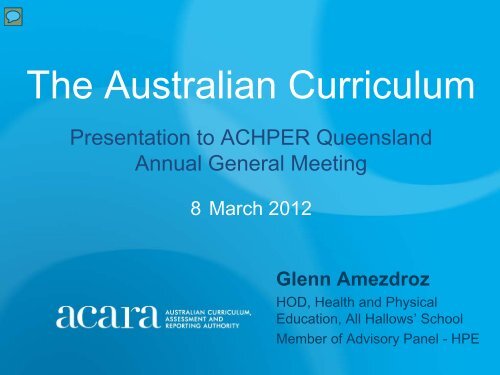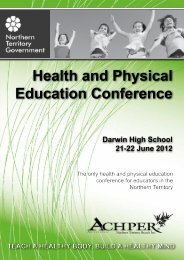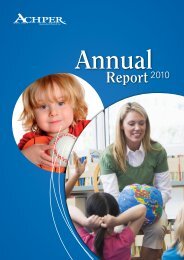The Australian Curriculum - ACHPER QLD
The Australian Curriculum - ACHPER QLD
The Australian Curriculum - ACHPER QLD
Create successful ePaper yourself
Turn your PDF publications into a flip-book with our unique Google optimized e-Paper software.
<strong>The</strong> <strong>Australian</strong> <strong>Curriculum</strong>Presentation to <strong>ACHPER</strong> QueenslandAnnual General Meeting8 March 2012Glenn AmezdrozHOD, Health and PhysicalEducation, All Hallows’ SchoolMember of Advisory Panel - HPE
<strong>The</strong> challenge!• World-class curriculum• 21 st century curriculum• National curriculum1
World-class curriculum• Evidence-based• Current research• Consultation• Inform the development of Shape paper2
21 st century curriculum• Consider child beginning primary school in 2012• Expected that they will continue initial educationuntil 2024• Many will continue in further education throughthe mid 2020’s and beyond• Adaptive knowledge, understandings, skills tomeet changing expectations of society3
National curriculum• Eight separate States and Territories• Stakeholders: Independent, Catholic andState sectors• Each with a different ethos• Consensus a challenge4
Health and Physical EducationDEVELOPMENT OFAUSTRALIANCURRICULUM5
<strong>Australian</strong> <strong>Curriculum</strong>: Health and PEShaping ProcessPositionPaperInitialAdvicePaperNationalForumShapePaper
<strong>Curriculum</strong> shaping - Shape Paper• Broad outline of proposed curriculum• Wide public consultation• Expert advice sought• Modification based on consultation andfeedback• Published on ACARA website7
<strong>Australian</strong> <strong>Curriculum</strong>: Health and PEProcessShape Paper Writing ImplementationMonitoringEvaluationReview
<strong>Curriculum</strong> writing• Teams of writers, supported by expertadvisory groups• Draft content descriptions andachievement standards for Foundation-12• Released for public consultation• Revised in light of feedback• Publication of AC-HPE on ACARA website9
<strong>Curriculum</strong> implementation• Delivered in online environment• Used by school authorities, schools,teachers• ACARA provides support for state andterritory curriculum and school authoritiesfor ongoing implementation planning10
<strong>Curriculum</strong> monitoring, evaluation andreview• Processes put in place to monitor andreview the <strong>Australian</strong> <strong>Curriculum</strong> based onimplementation feedback• Evaluation process may result in minorchanges to, or revision of, curriculum11
<strong>Curriculum</strong> Development Process – Health and PEStage Activity Key dates<strong>Curriculum</strong>ShapingConsultation<strong>Curriculum</strong>DevelopmentConfirmation of directions for writing<strong>Curriculum</strong>National Forum (Initial Advice Paper)Draft Shape Paper public consultation2 step process for development ofcurriculum documents• Step 1 - broad outline; scope andsequence• Step 2 – completion of ‘detail’ ofcurriculum2011 - 2012Final Shape Paperdue July 2012December 2011Mid Mar – end May2012July-Dec 2012Consultation National consultation and trialing Early 2013Publication Digital publication Second half 2013
SCOPE OF THE AUSTRALIANCURRICULUMGeneral capabilitiesCross-curriculum priorities13
General capabilities• Literacy• Numeracy• Information andCommunicationTechnology (ICT)competence• Critical and creativethinking• Ethical behaviour• Interculturalunderstanding• Personal and socialcompetence14
Cross-curriculum priorities• Aboriginal and Torres Strait Islanderhistories and cultures• Asia and Australia’s engagement with Asia• Sustainability15
<strong>Curriculum</strong><strong>Curriculum</strong><strong>The</strong> <strong>Australian</strong> <strong>Curriculum</strong> detailswhat students should learn (contentdescriptions) and describes thequality of learning expected(achievement standards)Organisation of learningand pedagogySchools and teachers are best placed todecide how to organise learning, takingaccount of the needs and interests ofstudents and school contextAssessment<strong>The</strong> <strong>Australian</strong> <strong>Curriculum</strong> doesnot specify how teachers /schools / curriculum authoritieswill assess student learning16
<strong>The</strong> whole curriculum – some assumptions• Teaching and learning programs are based on the<strong>Australian</strong> <strong>Curriculum</strong>• For any year, the <strong>Australian</strong> <strong>Curriculum</strong> is written so thatit should not take up more than 80% of the total teachingtime available• Decisions relating to the organisation and delivery of the<strong>Australian</strong> <strong>Curriculum</strong>, including such matters as timeallocations, rest with education authorities and schools• Scope for education authorities and/or schools to offeradditional learning opportunities beyond those providedby the <strong>Australian</strong> <strong>Curriculum</strong>17
Assumptions –• Schools and/or curriculum authorities willprovide learning opportunities in English,mathematics, science, history and healthand physical education from Foundation -Year Ten18
<strong>Australian</strong> <strong>Curriculum</strong>: Health and PhysicalEducation• A notional time of 80 hours per year (8%curriculum time) is a guide for writers forHPE.• Notional time allocation does not includeextra-curricular school sport programs.19
<strong>Australian</strong> <strong>Curriculum</strong>Health and Physical EducationPROPOSED AIMS20
Aims• learn to individually and collaborativelyaccess, evaluate and synthesiseinformation, make decisions, seek helpand take actions to protect, enhance andadvocate for their own and others’ healthand wellbeing21
Aims• develop and use personal and social skillsand strategies to promote a sense ofpersonal identity, wellbeing and to buildand maintain positive relationships22
Aims• acquire, apply and evaluate movementskills, concepts, and strategic awarenessand respond creatively and competently tophysical activity challenges23
Aims• understand and appreciate thesignificance of physical activity and sportto personal, social, cultural and healthpractices and outcomes24
Aims• analyse how personal, social, cultural,economic, technological andenvironmental factors shape health andphysical activity opportunities locally andglobally.25
<strong>Australian</strong> <strong>Curriculum</strong> -Health and Physical EducationTwo integrated strandsPROPOSAL26
Proposal• Personal, social and community health• Movement and physical activity27
Why two strands?• Two strands streamline opportunities forintegrated planning and provision ofcohesive learning experiences.• Links to Personal and social capability inGeneral Capabilities• Scope and sequence indicates integration28
<strong>Australian</strong> <strong>Curriculum</strong> –Health and Physical EducationPROPOSITIONSUNDERPINNING HPECURRICULUM DEVELOPMENT29
Propositions• Adopt a ‘strength-based’ approach• Focus on the educative outcomes of thelearning area• Develop ‘health literacy’ skills• Value learning in, about and throughphysical activity• Include a ‘socially critical’ perspective30
Strength-based approach• Most students come to the learning areafeeling positive about their health.• ‘<strong>The</strong> majority of young people rate theirhealth as “good”, “very good” or“excellent”’ (AIHW 2011).31
Strength-based approach• Current research indicates development ofknowledge, skills and attitudes has apositive effect on health behaviours andwellbeing• Regardless of current situation32
….educative outcomes• Not a ‘cure-all’ for a range of public healthconcerns about children and young people• Support the development of theknowledge, understandings and skillsstudents need to make healthy choicesabout health issues33
Health literacy• Nutbeam (2008) defines critical healthliteracy as the ability to selectively accessand critically analyse health information inorder to take action to promote personalhealth or the health of others.• Schools are recognised as key settings fordeveloping health-related knowledge andskills.34
In, about and through physicalactivity• Promote an appreciation of the centralityof movement in daily life, in all its forms.• Encourage lifelong participation in physicalactivity.35
Socially critical perspective• Question taken-for-granted assumptionsand power inequalities, explore aspects ofcultural difference, inclusiveness, diversityand social justice, and develop strategiesto achieve change.36
How do we keep informed?•ACARA websitewww.acara.edu.au/hpe.html•Janice AtkinSenior Project Officer, Health and Physical EducationE: janice.atkin@acara.edu.au)
Getting involved• Shape paper and online consultationsurvey - access through ACARA website(www.acara.edu.au/hpe.html)• Forums run by jurisdictions andprofessional associations• Written submissions from individuals andorganisations38
Questions?39




